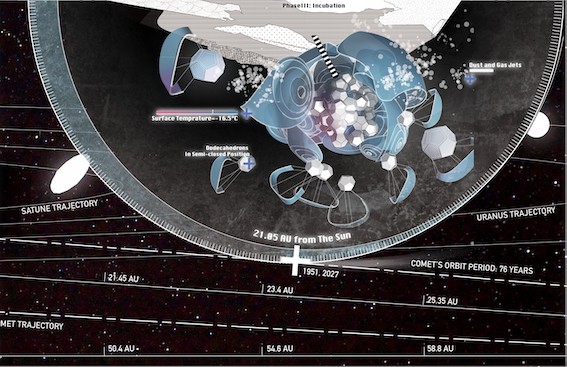A Space Oddity
Fairy Tales Competition, 2016
Project Team:
El Hadi Jazairy + Rania Ghosn
Jia Weng, Ya Suo, Sihao Xiong, Bin Zhang
In 1682, an icy celestial body crossed the sky following the same path as others in 1531 and 1607. Using the Law of Gravity, which was developed by his friend Sir Isaac Newton, Edmond Halley showed that the three different appearances were actually the same comet travelling around the Sun in a long orbit and returning every 76 years. He predicted that the comet was periodic, and would reappear in 1758. In 1759, the comet came back, a little late because Jupiter’s strong gravity slowed it down. Halley’s Comet has also returned in 1835, 1910, and in 1986. In its last sojourn through the inner solar system, five space probes flew through Halley's tail. They closely observed the jets of evaporating material and snapped thousands of photographs as they swept by. Perhaps you remember seeing a faint fuzzy patch in the sky or the comet for yourself through binoculars.
In 2060, Sir Isaac Newton returns to Cambridge to head the Halley Armada.
The space mission seeks to build alien life forms using stardust, architectural structures, Halley’s trajectory, and the associated set of physical processes and chemical compounds across its expansive temperature range. Is there life, not as we know it? There are good reasons for this cosmological assignment. To astronomers, a comet is a flying natural history museum stocked with precious artifacts from the very earliest moments of the solar system. They are the leftovers of the day of creation, the odd bits and pieces of simple unused matter when the Sun and its attendant planets came into their present form. Comets are like a cosmic refrigerator, says Sir Newton, They've internally preserved the whole history of the solar system. By plowing into Halley's cold heart and sniffing out the dust and gases that stream from its surface, the Halley Armada experiments with the conditions that existed at the birth of the sun and the nine planets some 4.5 billion years ago.
The Halley Armada spacecraft is launched at the moment Comet Halley approaches the Earth in 2062. The mission patch reads: Love your Monsters. The space probe is composed of 30 dodecahedron modules, each of which hosts a hairy palpal bulb that transfers life cells and is enveloped by a soft membrane. Landing in Halley’s Central Depression, the parasite fleet leeches off the body of its host. In this primal moment of insemination, the Halley Armada implants its feeding-stem to suck liquid from the comet’s nucleus that is at mostly ice from water.
The Halley Armada dodecahedrons respond to the comet’s changing milieu between the days of perihelion and aphelion: it reconfigures between the closest and most distant points in Halley’s orbit to the sun. As this dirty snowball swoops toward the sun, solar radiation begins to vaporize ice and frozen gases on the comet's sunward surface. This process of sublimation changes the comet’s state from nebulous to crystalline. The energy liberated by the melting comet inflates the membranes. The blooming surfaces of the polyhedrons harness radiant light and heat from the sun in a process of artificial photosynthesis. The envelopes collapse back as the comet moves away from the sun. Sitting in a tin can, far above the world. In the comet’s journey through the Solar System, the dormant monsters incubate, weave their web, and assemble into one large blue egg. Irritated by trillions of objects and icy debris that surrounds our solar system, the egg hatches a swarm of spider monsters. A garden of cosmic delights spurts beyond the Oort Cloud. See the spiders in their million hordes. Oh man! Look at those spiders go. It's the freakiest show.
And the same thing happens every 76 years; this great coitus with the celestial atmosphere is regulated by the comet’s rotation around the sun. In 2138, the Earth’s octogenarians -and those close to becoming one- are going to be treated to “The 2062 Halley's Comet Club.” Memories of the brilliant 2062 visitation, when Halley's passed within 50 million miles of Earth are strikingly vivid. Blasting away: “Planet Earth is blue. And there's nothing I can do.”
Well, the cycle repeats until the comet eventually disintegrates into meteor swarms. Till then, the Spiders from Halley celebrate the call to love our monsters and care for our technologies as we do our children. Each monster is a message in a bottle: it brings forth new possibilities for the meanings of difference, reproduction, and survival, all the while engaging the most significant things that define us as humans on Earth, which are stories. On Comet Halley, the formal reconfiguration of the monsters has no end; its cycle has continuations, interruptions and reformulations – just as the kind of survivable stories we could use these days. This one is written from within the belly of the monster.
